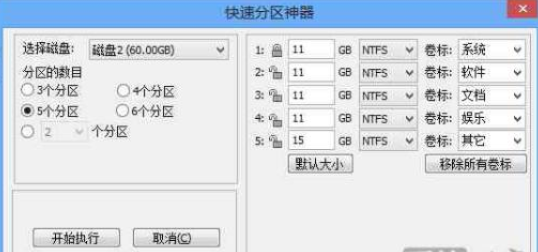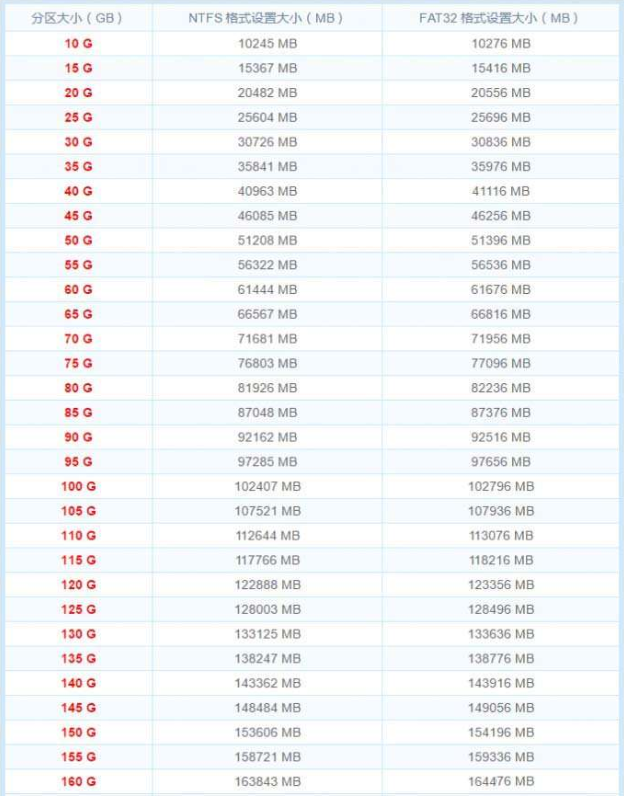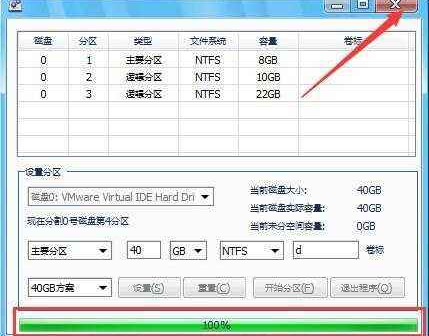 System Tutorial
System Tutorial
 Windows Series
Windows Series
 Integer calculation solution for win10 partition defragmentation
Integer calculation solution for win10 partition defragmentation
Integer calculation solution for win10 partition defragmentation
If you simply enter the calculated value as 1GB = 1024 MB when partitioning in Windows, you will always get a result like 259.5 GB / 59.99 GB / 60.01 GB instead of an integer, then the win10 partition integer How is it calculated? Let’s take a look with the editor below.
Win10 partition integer calculation formula:
1. The formula is: (X-1)×4 1024×X=Y.
2. If you want to get the integer partition of Windows, you must know a formula. The value calculated through this formula can be recognized by Windows as an integer GB value.
3. Among them, X is the integer partition value you want to get, the unit is GB, Y is the number that should be entered when partitioning, the unit is MB.
4. For example, if you want to get 3GB of space under Windows, you should enter (3-1)×4 1024×3=3080 when partitioning.
5. The following are some common examples.
5GB: (5-1)×4 1024×5=5136
10GB: (10-1)×4 1024×10=10276
15GB: (15 -1)×4 1024×15=15416
20GB: (20-1)×4 1024×20=20556

6. In a different dimension The website once launched an "online hard disk integer partition calculator". You can enter the integer GB value you want, and it will help you calculate how many MB you need to enter.
However, many people find that after entering this result directly, they still cannot get an integer when dividing the first area (that is, C drive). In fact, there is something to pay attention to here.
Because when Windows divides the first partition, it will automatically create 3 additional hidden partitions, their sizes are as follows (this is when I installed Windows 10 on Surface Pro 3 as an example,
7. Not sure whether the hidden partition sizes of different versions of the system are the same, please refer to your own computer): the hidden partition size list automatically created by Windows 10.
450 MB Recovery Partition
100 MB System Partition
16 MB MSR (Reserved)

8. Therefore, when calculating the first partition, you should first delete all hidden partitions (only one unallocated space is left in the list) and try to create it once partition, get the size of all hidden partitions and write them down. Delete them all again and recreate them.
Then add the result of the "Online Integer Partition Calculator" to the sum of the sizes of these hidden partitions to achieve integer partitioning.
For example, I take 60GB as an example and use the calculator to get �0�261444 MB. Then the value I finally need to enter for the first partition should be �0�261444 450 100 16 = 62010.

9. So in summary: C drive partition size = the value obtained by the calculator, the sum of the hidden partition sizes and other partition sizes = the value obtained by the calculator, Windows 10 All integer partitions of drive C can be calculated according to this method. For the remaining partitions, just enter the values in the calculator.
The above is the detailed content of Integer calculation solution for win10 partition defragmentation. For more information, please follow other related articles on the PHP Chinese website!

Hot AI Tools

Undresser.AI Undress
AI-powered app for creating realistic nude photos

AI Clothes Remover
Online AI tool for removing clothes from photos.

Undress AI Tool
Undress images for free

Clothoff.io
AI clothes remover

Video Face Swap
Swap faces in any video effortlessly with our completely free AI face swap tool!

Hot Article

Hot Tools

Notepad++7.3.1
Easy-to-use and free code editor

SublimeText3 Chinese version
Chinese version, very easy to use

Zend Studio 13.0.1
Powerful PHP integrated development environment

Dreamweaver CS6
Visual web development tools

SublimeText3 Mac version
God-level code editing software (SublimeText3)

Hot Topics
 Is the company's security software causing the application to fail to run? How to troubleshoot and solve it?
Apr 19, 2025 pm 04:51 PM
Is the company's security software causing the application to fail to run? How to troubleshoot and solve it?
Apr 19, 2025 pm 04:51 PM
Troubleshooting and solutions to the company's security software that causes some applications to not function properly. Many companies will deploy security software in order to ensure internal network security. ...
 Navicat's solution to the database cannot be connected
Apr 08, 2025 pm 11:12 PM
Navicat's solution to the database cannot be connected
Apr 08, 2025 pm 11:12 PM
The following steps can be used to resolve the problem that Navicat cannot connect to the database: Check the server connection, make sure the server is running, address and port correctly, and the firewall allows connections. Verify the login information and confirm that the user name, password and permissions are correct. Check network connections and troubleshoot network problems such as router or firewall failures. Disable SSL connections, which may not be supported by some servers. Check the database version to make sure the Navicat version is compatible with the target database. Adjust the connection timeout, and for remote or slower connections, increase the connection timeout timeout. Other workarounds, if the above steps are not working, you can try restarting the software, using a different connection driver, or consulting the database administrator or official Navicat support.
 What to do if Redis memory usage is too high?
Apr 10, 2025 pm 02:21 PM
What to do if Redis memory usage is too high?
Apr 10, 2025 pm 02:21 PM
Redis memory soaring includes: too large data volume, improper data structure selection, configuration problems (such as maxmemory settings too small), and memory leaks. Solutions include: deletion of expired data, use compression technology, selecting appropriate structures, adjusting configuration parameters, checking for memory leaks in the code, and regularly monitoring memory usage.
 What are the common misunderstandings in CentOS HDFS configuration?
Apr 14, 2025 pm 07:12 PM
What are the common misunderstandings in CentOS HDFS configuration?
Apr 14, 2025 pm 07:12 PM
Common problems and solutions for Hadoop Distributed File System (HDFS) configuration under CentOS When building a HadoopHDFS cluster on CentOS, some common misconfigurations may lead to performance degradation, data loss and even the cluster cannot start. This article summarizes these common problems and their solutions to help you avoid these pitfalls and ensure the stability and efficient operation of your HDFS cluster. Rack-aware configuration error: Problem: Rack-aware information is not configured correctly, resulting in uneven distribution of data block replicas and increasing network load. Solution: Double check the rack-aware configuration in the hdfs-site.xml file and use hdfsdfsadmin-printTopo
 Can vs code run in Windows 8
Apr 15, 2025 pm 07:24 PM
Can vs code run in Windows 8
Apr 15, 2025 pm 07:24 PM
VS Code can run on Windows 8, but the experience may not be great. First make sure the system has been updated to the latest patch, then download the VS Code installation package that matches the system architecture and install it as prompted. After installation, be aware that some extensions may be incompatible with Windows 8 and need to look for alternative extensions or use newer Windows systems in a virtual machine. Install the necessary extensions to check whether they work properly. Although VS Code is feasible on Windows 8, it is recommended to upgrade to a newer Windows system for a better development experience and security.
 Centos minio installation permissions issues
Apr 14, 2025 pm 02:00 PM
Centos minio installation permissions issues
Apr 14, 2025 pm 02:00 PM
Permissions issues and solutions for MinIO installation under CentOS system When deploying MinIO in CentOS environment, permission issues are common problems. This article will introduce several common permission problems and their solutions to help you complete the installation and configuration of MinIO smoothly. Modify the default account and password: You can modify the default username and password by setting the environment variables MINIO_ROOT_USER and MINIO_ROOT_PASSWORD. After modification, restarting the MinIO service will take effect. Configure bucket access permissions: Setting the bucket to public will cause the directory to be traversed, which poses a security risk. It is recommended to customize the bucket access policy. You can use MinIO
 Can visual studio code be used in python
Apr 15, 2025 pm 08:18 PM
Can visual studio code be used in python
Apr 15, 2025 pm 08:18 PM
VS Code can be used to write Python and provides many features that make it an ideal tool for developing Python applications. It allows users to: install Python extensions to get functions such as code completion, syntax highlighting, and debugging. Use the debugger to track code step by step, find and fix errors. Integrate Git for version control. Use code formatting tools to maintain code consistency. Use the Linting tool to spot potential problems ahead of time.
 How to deal with Redis memory fragmentation?
Apr 10, 2025 pm 02:24 PM
How to deal with Redis memory fragmentation?
Apr 10, 2025 pm 02:24 PM
Redis memory fragmentation refers to the existence of small free areas in the allocated memory that cannot be reassigned. Coping strategies include: Restart Redis: completely clear the memory, but interrupt service. Optimize data structures: Use a structure that is more suitable for Redis to reduce the number of memory allocations and releases. Adjust configuration parameters: Use the policy to eliminate the least recently used key-value pairs. Use persistence mechanism: Back up data regularly and restart Redis to clean up fragments. Monitor memory usage: Discover problems in a timely manner and take measures.





